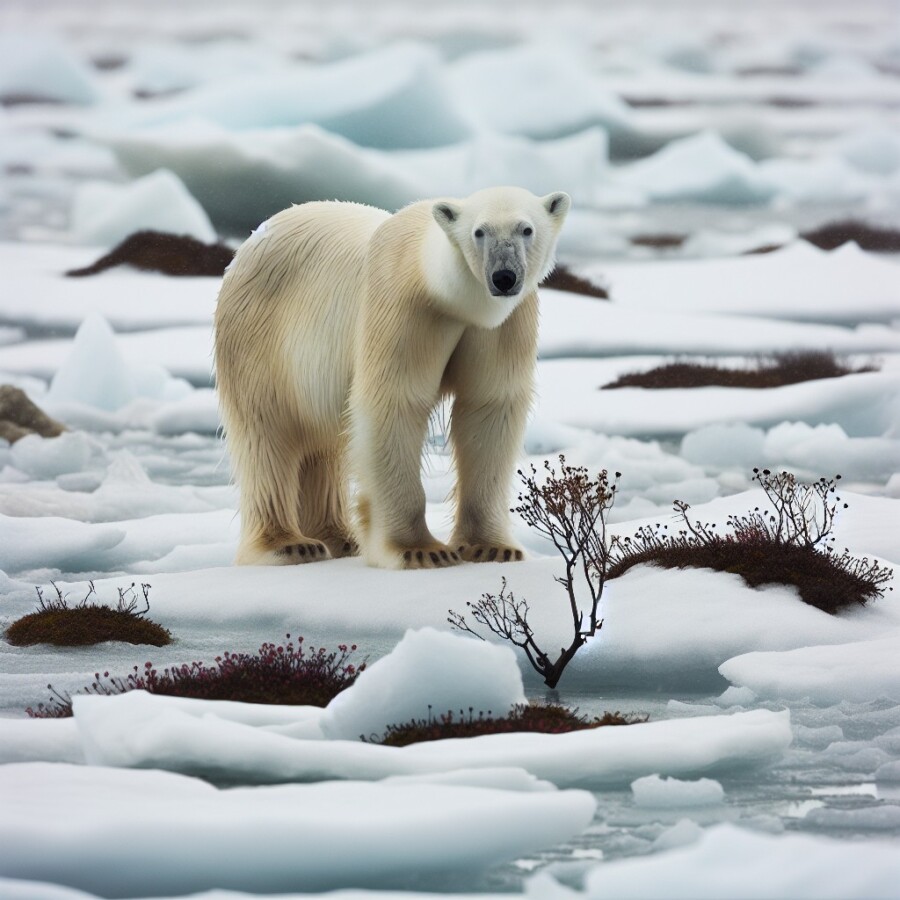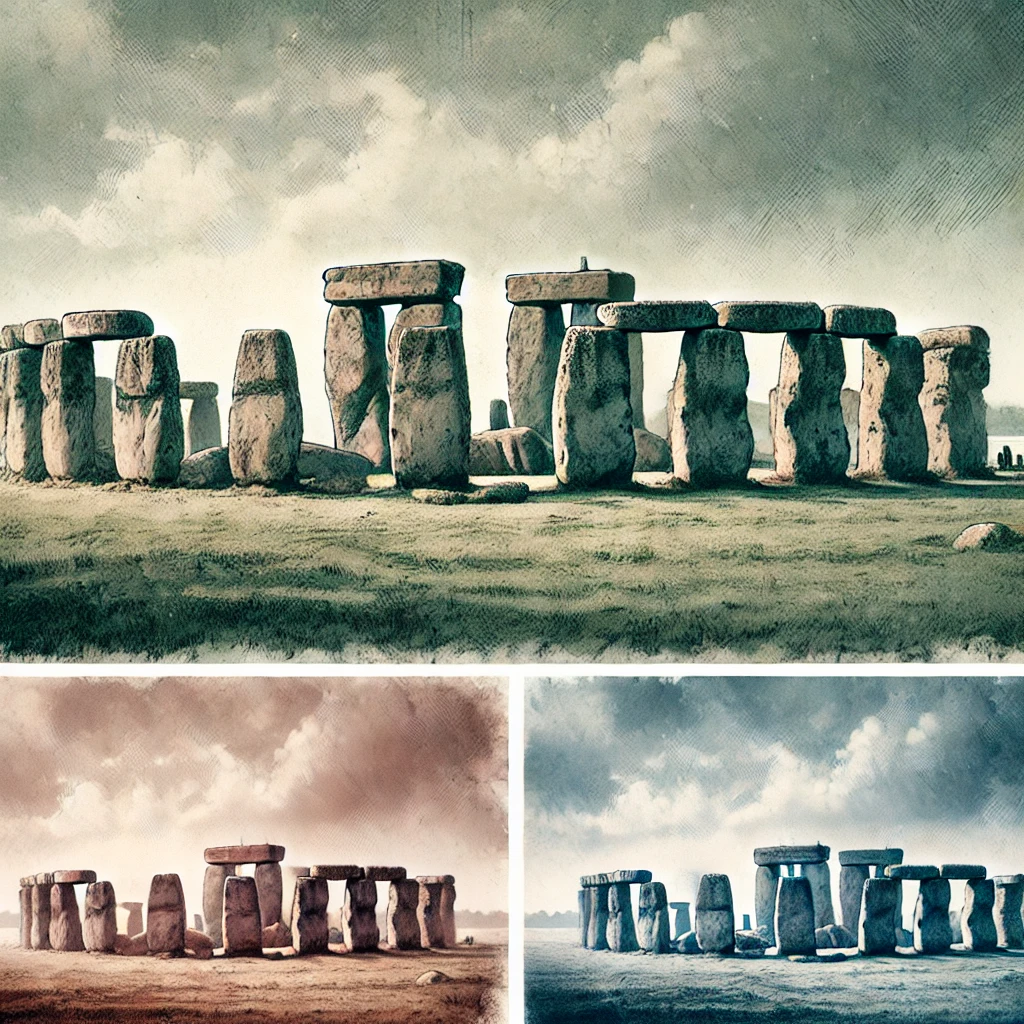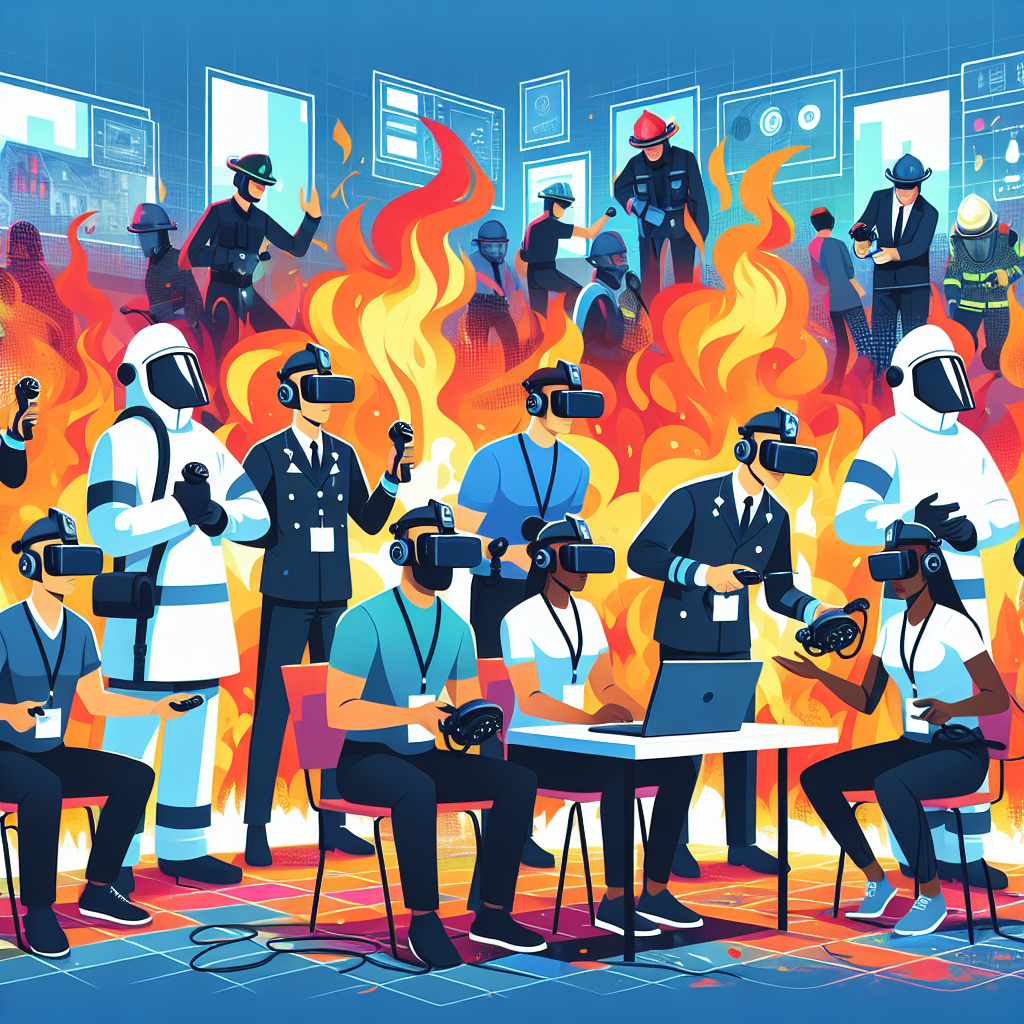Polar bears are big white bears that live in the Arctic, where it’s very cold and icy. They usually eat seals that they catch on the ice. But because the Earth is getting warmer, the ice is melting, and the bears can’t find as many seals to eat. Instead, they have to eat things like bird’s eggs and berries, but these foods don’t keep them healthy and strong.
People all over the world know about polar bears and how they are having a hard time because of the Earth getting warmer. A long time ago, there weren’t as many polar bears because people hunted them too much. But then, people made rules to protect the bears, and their numbers started to grow again. However, now the biggest problem for the bears is not enough ice to hunt on because of the warm weather.
Scientists did a study where they watched 20 polar bears to see how they lived without much ice. This study happened over three years. They found out that the bears tried different ways to survive, like eating plants or resting a lot to save energy. But these methods didn’t work well. Almost all the bears lost weight, with some losing more than 10% of their body weight.
Original news source: Polar bears face starvation threat as ice melts (BBC)
🎧 Listen:
Slow
Normal
Fast
📖 Vocabulary:
| 1 | Arctic | A very cold area around the North Pole |
| 2 | seals | Animals that live in the sea and are eaten by polar bears |
| 3 | melting | Turning from ice into water |
| 4 | berries | Small, sweet fruits that grow on bushes or trees |
| 5 | hunted | Chased and killed for food or sport |
| 6 | protect | Keep safe from harm |
| 7 | scientists | People who learn about the world by doing experiments |
| 8 | study | A detailed examination of something to learn more about it |
| 9 | survive | To keep living, especially in hard times |
| 10 | plants | Living things that grow in the ground, like flowers or vegetables |
| 11 | energy | The power needed to do things |
| 12 | weight | How heavy someone or something is |
Group or Classroom Activities
Warm-up Activities:
– News Summary
Instructions: Divide the class into pairs or small groups. Give each group a few minutes to read the article. Then, ask them to summarize the main points of the article in a short news summary. They can focus on the issue of polar bears struggling to find food due to melting ice. Afterward, have each group share their summaries with the class.
– Sketch It
Instructions: In pairs, have students take turns describing a scene from the article to each other. The listener must then sketch what they heard based on the description. After a few rounds, have students compare their sketches and discuss any differences or similarities. This activity helps practice listening comprehension and descriptive skills.
– Vocabulary Pictionary
Instructions: Write down some key vocabulary words from the article on separate slips of paper. Divide the class into two teams. One student from each team comes up to the front and picks a slip of paper. They must then draw a picture to represent the word while their team tries to guess it. The team with the most correct guesses wins.
– Pros and Cons
Instructions: Divide the class into small groups. Assign each group either the role of a scientist studying polar bears or a government official responsible for making decisions about protecting the environment. Have them discuss the pros and cons of different actions that can be taken to help the polar bears, such as reducing greenhouse gas emissions or creating protected areas for the bears. Afterward, have each group present their arguments to the class.
– Future Predictions
Instructions: In pairs, have students take turns making predictions about what might happen to polar bears in the future if the Earth continues to warm. Encourage them to use language such as “might,” “could,” or “probably.” Afterward, have a class discussion and ask students to share their predictions. This activity helps practice using future tenses and expressing opinions.
🤔 Comprehension Questions:
1. What do polar bears usually eat?
2. Why can’t polar bears find as many seals to eat?
3. What are some other foods that polar bears have to eat when they can’t find seals?
4. What happened to the number of polar bears a long time ago?
5. What is the biggest problem for polar bears now?
6. What did scientists do to study polar bears?
7. What happened to the bears’ weight during the study?
Go to answers ⇩
🎧✍️ Listen and Fill in the Gaps:
Polar (1)______ are big (2)______ bears that live in the Arctic, where it’s very cold and icy. They usually eat seals that they catch on the ice. But because the Earth is getting warmer, the ice is melting, and the bears can’t find as many seals to eat. Instead, they have to eat (3)______ like bird’s (4)______ and berries, but these foods don’t keep them healthy and strong.
People all over the world know about (5)______ bears and how they are having a hard time because of the (6)______ getting warmer. A long time ago, there weren’t as many polar bears because people hunted them too much. But then, (7)______ made (8)______ to (9)______ the bears, and their numbers started to grow again. However, now the biggest problem for the bears is not enough ice to hunt on because of the warm weather.
Scientists did a study where they watched 20 polar bears to see how they lived without much ice. This study (10)______ over three years. They (11)______ out that the bears tried (12)______ ways to survive, like eating plants or resting a lot to save energy. But these methods didn’t work well. Almost all the bears lost weight, with some losing more than 10% of their body weight.
Go to answers ⇩
💬 Discussion Questions:
Students can ask a partner these questions, or discuss them as a group.
1. What is a polar bear?
2. How do polar bears usually catch their food?
3. How is the Earth getting warmer affecting the polar bears?
4. What do polar bears have to eat when they can’t find seals?
5. Why are bird’s eggs and berries not good for polar bears?
6. Do you think it’s important to protect polar bears? Why or why not?
7. How did people help the polar bears in the past?
8. What is the biggest problem for polar bears now?
9. How did scientists study the polar bears?
10. What did the scientists find out about how the polar bears tried to survive?
11. How did the polar bears’ weight change during the study?
12. How do you think the polar bears feel when they can’t find enough food?
Individual Activities
📖💭 Vocabulary Meanings:
Match each word to its meaning.
Words:
1. Arctic
2. seals
3. melting
4. berries
5. hunted
6. protect
7. scientists
8. study
9. survive
10. plants
11. energy
12. weight
Meanings:
(A) Chased and killed for food or sport
(B) Turning from ice into water
(C) To keep living, especially in hard times
(D) Animals that live in the sea and are eaten by polar bears
(E) The power needed to do things
(F) How heavy someone or something is
(G) Living things that grow in the ground, like flowers or vegetables
(H) People who learn about the world by doing experiments
(I) A very cold area around the North Pole
(J) Small, sweet fruits that grow on bushes or trees
(K) Keep safe from harm
(L) A detailed examination of something to learn more about it
Go to answers ⇩
🔡 Multiple Choice Questions:
1. Where do polar bears live?
(a) The Antarctic
(b) The Sahara Desert
(c) The Arctic
(d) The Amazon Rainforest
2. What do polar bears usually eat?
(a) Seals
(b) Fish
(c) Birds
(d) Berries
3. Why are polar bears having a hard time finding food?
(a) There are too many seals
(b) They are too lazy to hunt
(c) They don’t like seals
(d) The ice is melting
4. What did people do to help protect polar bears?
(a) Hunted them even more
(b) Made rules to protect them
(c) Ignored them
(d) Moved them to a different habitat
5. What is the biggest problem for polar bears now?
(a) Too many seals to catch
(b) Too much snow
(c) Not enough ice to hunt on
(d) Too many birds to eat
6. How long did the study on polar bears last?
(a) Three years
(b) One month
(c) One week
(d) Ten years
7. What did the scientists find out about the bears in the study?
(a) They gained weight
(b) They didn’t change
(c) They disappeared
(d) They lost weight
8. What did the bears try to do to survive without much ice?
(a) Swim more
(b) Eat plants
(c) Sleep less
(d) Hunt more seals
Go to answers ⇩
🕵️ True or False Questions:
1. Rules were made to harm the bears, and their numbers started to decline again.
2. Now, the biggest problem for polar bears is too much ice hinder their movement because of the cold weather.
3. People all over the world know about polar bears and how they are struggling because of the warm weather.
4. In the past, there were not many polar bears because people hunted them too much.
5. Polar bears live in the Antarctic where it is very hot and sandy.
6. Instead of seals, polar bears have to eat things like bird’s eggs and insects, which are not as good for their health.
7. They usually eat seals that they catch on the ice.
8. The Earth getting warmer is causing the ice to melt, making it harder for polar bears to find seals to eat.
Go to answers ⇩
📝 Write a Summary:
Write a summary of this news article in two sentences.
Check your writing now with the best free AI for English writing!
Writing Questions:
Answer the following questions. Write as much as you can for each answer.
Check your answers with our free English writing assistant!
1. What do polar bears usually eat?
2. Why are polar bears having a hard time finding enough food?
3. How did people help increase the number of polar bears in the past?
4. What is the biggest problem for polar bears now?
5. What did scientists find out about polar bears in their study?
✅ Answers
🤔✅ Comprehension Question Answers:
1. What do polar bears usually eat?
Polar bears usually eat seals.
2. Why can’t polar bears find as many seals to eat?
Polar bears can’t find as many seals to eat because the ice is melting and there is less ice for them to hunt on.
3. What are some other foods that polar bears have to eat when they can’t find seals?
When polar bears can’t find seals, they have to eat things like bird’s eggs and berries.
4. What happened to the number of polar bears a long time ago?
A long time ago, the number of polar bears decreased because people hunted them too much.
5. What is the biggest problem for polar bears now?
The biggest problem for polar bears now is not having enough ice to hunt on because of the warm weather.
6. What did scientists do to study polar bears?
Scientists watched 20 polar bears over three years to study how they lived without much ice.
7. What happened to the bears’ weight during the study?
During the study, almost all the bears lost weight, with some losing more than 10% of their body weight.
Go back to questions ⇧
🎧✍️✅ Listen and Fill in the Gaps Answers:
(1) bears
(2) white
(3) things
(4) eggs
(5) polar
(6) Earth
(7) people
(8) rules
(9) protect
(10) happened
(11) found
(12) different
Go back to questions ⇧
📖💭✅ Vocabulary Meanings Answers:
1. Arctic
Answer: (I) A very cold area around the North Pole
2. seals
Answer: (D) Animals that live in the sea and are eaten by polar bears
3. melting
Answer: (B) Turning from ice into water
4. berries
Answer: (J) Small, sweet fruits that grow on bushes or trees
5. hunted
Answer: (A) Chased and killed for food or sport
6. protect
Answer: (K) Keep safe from harm
7. scientists
Answer: (H) People who learn about the world by doing experiments
8. study
Answer: (L) A detailed examination of something to learn more about it
9. survive
Answer: (C) To keep living, especially in hard times
10. plants
Answer: (G) Living things that grow in the ground, like flowers or vegetables
11. energy
Answer: (E) The power needed to do things
12. weight
Answer: (F) How heavy someone or something is
Go back to questions ⇧
🔡✅ Multiple Choice Answers:
1. Where do polar bears live?
Answer: (c) The Arctic
2. What do polar bears usually eat?
Answer: (a) Seals
3. Why are polar bears having a hard time finding food?
Answer: (d) The ice is melting
4. What did people do to help protect polar bears?
Answer: (b) Made rules to protect them
5. What is the biggest problem for polar bears now?
Answer: (c) Not enough ice to hunt on
6. How long did the study on polar bears last?
Answer: (a) Three years
7. What did the scientists find out about the bears in the study?
Answer: (d) They lost weight
8. What did the bears try to do to survive without much ice?
Answer: (b) Eat plants
Go back to questions ⇧
🕵️✅ True or False Answers:
1. Rules were made to harm the bears, and their numbers started to decline again. (Answer: False)
2. Now, the biggest problem for polar bears is too much ice hinder their movement because of the cold weather. (Answer: False)
3. People all over the world know about polar bears and how they are struggling because of the warm weather. (Answer: True)
4. In the past, there were not many polar bears because people hunted them too much. (Answer: True)
5. Polar bears live in the Antarctic where it is very hot and sandy. (Answer: False)
6. Instead of seals, polar bears have to eat things like bird’s eggs and insects, which are not as good for their health. (Answer: False)
7. They usually eat seals that they catch on the ice. (Answer: True)
8. The Earth getting warmer is causing the ice to melt, making it harder for polar bears to find seals to eat. (Answer: True)
Go back to questions ⇧













